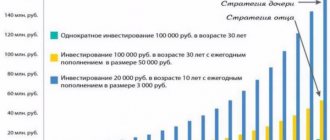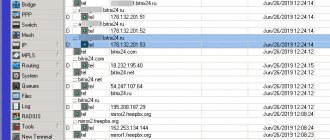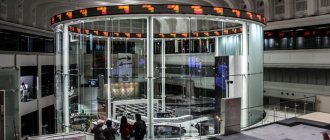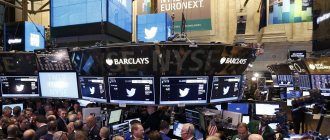What is a stock index in simple words
Stock index ( Index
) or, as it is also called
a stock index
is an indicator of price changes for a certain group of securities. Most often, indices are created specifically to track the overall health of a particular stock market, for example, the NASDAQ 100 index includes shares of the 100 largest companies on the NASDAQ exchange, and the NASDAQ Biotechnology index includes the 190 largest companies by capitalization only in the medical and biotech industry.
If the name of the index contains a numerical value, it indicates the number of companies included in the “basket”, according to which the index is calculated, for example, CAC 40 is the French index of the 40 largest companies in the country, or Nikkei 225 is the Japanese index, calculated from the 225 largest shares by capitalization of Japanese companies.
If we talk about what a stock index is in simple words, then it is a ready-made portfolio of shares, the value of which can show the dynamics of the development of an industry or even the country’s economy.
In order to calculate overall indicators, each index must have some kind of calculation basis, that is, the composition of the companies' securities - this is called the “ basket”
" This “basket” may include, for example, shares of the country’s largest industrial enterprises, the largest film companies, auto concerns, and so on by industry.
Stock index quotes
Stock index quotes reflect the average price of shares. At the same time, the absolute value of the indicators is uninformative; only the dynamics are important. If the index shows growth, then the largest corporations are in perfect order, and we can conclude that, in general, the economic sector in the country is “healthy”; if the indices are falling, it means that investors have begun to get rid of shares - a sign that the country’s economy Not everything is so rosy, there are reasons for concern.
Legally, indices are owned by individual companies, which belong to the owners and main shareholders of exchanges, as well as private companies. A striking example is the S&P 500 index, its basket and calculation belong to Standard & Poors
, which was founded in 1860 (
the S&P 500 index itself appeared only in 1957
).
Today, Standard & Poors is a reputable international rating agency engaged in financial market analytics and is owned by the parent company McGraw-Hill
, which since 2020 has been called
S&P Global
Inc.
Family of stock indexes
Each stock exchange or company has a number of indices, which have so-called sub-indices, collectively this is called a stock index family. For example, take the main stock index of China - Hang Seng, which belongs to HSI Services Limited
. This index appeared in 1969, and today the capitalization of its basket exceeds 3 trillion. dollars, the number of companies changes periodically and fluctuates around 50.
Later, Hang Seng acquired a whole family of indices:
- Hang Seng Finance Sub-index - calculated based on the value of the 12 largest banks and insurance companies.
- Hang Seng Utilities Sub-index - calculated on the basis of four fuel and energy companies.
- Hang Seng Properties Sub-index - calculated on the basis of investment and asset management companies.
- Hang Seng Commerce & Industry Sub-index - calculated on the basis of 25 industrial and trading companies.
- The Hang Seng China Enterprises Index (“H-shares Index”) is an index of the largest 40 mainland Chinese H-shares traded on the Hong Kong Stock Exchange.
- Hang Seng China-Affiliated Corporations Index is an index of 25 companies controlled by mainland China, but located actually outside this territory. They are traded on the Hong Kong Stock Exchange and are called Red Chips.
- Hang Seng China (Hong Kong-listed) 100 Index – an index of the 100 largest companies, which includes H-shares, red chips, and other companies traded on the Hong Kong Stock Exchange.
- Hang Seng HK 35 is an index of the 35 largest companies outside mainland China.
- Hang Seng Stock Connect Hong Kong Index is an index of companies traded through the Connect program, uniting the Shanghai, Shenzhen and Hong Kong stock exchanges. This index includes the similar mid- and small-cap indices (Hang Seng Stock Connect Hong Kong MidCap & SmallCap Index) and the small-cap index (Hang Seng Stock Connect Hong Kong SmallCap Index), traded under the Connect program.
The same Dow Jones index also has a huge family, like any other major stock index.
Take a look at the New York Exchange's family of stock indexes:
NYSE Arca Family of Indexes
| Index name | SYMBOL | BB CODE | REUTERS CODE |
| NYSE Arca Airline Index | XAL | XAL | .XAL |
| NYSE Arca Junior Gold BUGS Index | JHUI | JHUI | .JHUI |
| NYSE Arca Biotechnology Index | BTK | BTK | .BTK |
| NYSE Arca Major Market Index | XMI | XMI | .XMI |
| NYSE Arca Computer Hardware Index | HWI | HWI | .HWI |
| NYSE Arca Mexico Index | MXY | MXY | .MXY |
| NYSE Arca Defense Index | DFI | DFI | .DFII |
| NYSE Arca Mini-Biotechnology Index | B.J.E. | B.J.E. | .BJE |
| NYSE Arca Electric & Gas Infrastructure Index | RPE | RPE | .RPE |
| NYSE Arca Mini-Natural Gas Index | MNG | MNG | .MNG |
| NYSE Arca Equal Weighted Pharmaceutical Index | DGE | DGE | .DGE |
| NYSE Arca Mini-Oil Index | BZJ | BZJ | .BZJ |
| NYSE Arca Gold BUGS Index | HUI | HUI | .HUI |
| NYSE Arca Mini-Pharmaceutical Index | KBK | KBK | .KBK |
| NYSE Arca Hong Kong 30 Index | HKX | HKX | .HKX |
| NYSE Arca Mini-Securities Broker/Dealer Index | JBV | JBV | .JBV |
| NYSE Arca Institutional Index | XII | XII | .XII |
| NYSE Arca Natural Gas Index | XNG | XNG | .XNG |
| NYSE Arca Japan Index | JPN | JPN | .JPN |
| NYSE Arca Networking Index | NWX | NWX | .NWX |
| NYSE Arca China Index | CZH | CZH | .CZH |
| NYSE Arca North American Telecommunications Index | XTC | XTC | .XTC |
| NYSE Arca Disk Drive Index | DDX | DDX | .DDX |
| NYSE Arca Oil Index | XOI | XOI | .XOI |
| NYSE Arca Global Airline Index | AXGAL | AXGAL | .AXGAL |
| NYSE Arca Pharmaceutical Index | DRG | DRG | .DRG |
| NYSE Arca Hong Kong Option Index | HKO | HKO | .HKO |
| NYSE Arca Securities Broker/Dealer Index | XBD | XBD | .XBD |
| NYSE Arca Airline Total Return Index | MLXAL | MLXAL | .MLXAL |
| NYSE Arca Semiconductor Index | SIS | SIS | .SIS |
| NYSE Arca Environmental Services Index | AXENV | AXENV | .AXES |
| NYSE Arca Gold Miners Index | GDM | GDM | .GDM |
| NYSE Arca International Market Index | ADR | ADR | .ADR |
| NYSE Arca Computer Technology Index | XCI | XCI | .XCI |
| NYSE Arca Steel Index | STEEL | STEEL | .STTL |
| NYSE Arca Tech 100 Index | PSE | PSE | .PSE |
| NYSE Arca Telecommunications Index | PHN | PHN | .PHN |
| NYSE Arca Tobacco Index | TOB | TOBX | .TOB |
Why are stock indices needed?
Content
- The index can act as an object of trade as an underlying commodity
- The most common indices are in the stock market
- Average market prices of individual exchanges are called exchange averages
- Market indices are made up of indices of significant companies
- The geometric mean method allows you to replace components
- Differences between indices and stock averages
- The current state of the market is compared with the base period
- Total capitalization is compared with the previous period
- Based on the indices, investors get an unbiased picture
- When calculating indices, sampling is done differently
- Small sample size makes calculations simpler and cheaper
- The representativeness of the index is related to the establishment of certain sampling criteria
- Analysis of the methodology for calculating the RBC index
- In the absence of quotes, the issuer remains listed
- Adjustment of components is achieved by revising the sample
- Index calculation frequency
- The isolated index is not of particular interest
- Sources and links
Open publication content
Collapse article structure
information function of a stock index
Indices were invented so that
stock traders could get the information they needed about what was happening in the market.
Therefore, initially indexes performed only an information function. Reflecting the direction of movement of stock quotes - up or down, they showed the trends that the stock market takes and the speed of their development. The accumulation of certain data on the state of stock exchange indices has made it possible to use them as a forecast: you can always find a similar situation in the past, and the index movement that was demonstrated before can be repeated at the present time. Video 1
The index can act as an object of trade as an underlying commodity
With the development of the stock market, the use of the index becomes multifunctional. The index acts as an object of trade, for example as an underlying commodity for which a futures contract is developed. In addition, indices are actively used in portfolio investing. At the same time they:
firstly, they serve as a guide for the selection of securities for the portfolio, determining the directions and proportions of investment;
secondly, they reduce dealer costs when applying passive portfolio management tactics when using the index fund method.
Video 2
The most common indices are in the stock market
Indices can be sectoral, regional, summary and global. They can be used in any market: commodity, currency, stock. Although it should be emphasized that they originated in the stock market and are still most widespread in this market.
The indices get their name from the name of the creator of the methodology or the name of the news agencies that calculate and publish them. For example, the Dow Jones index is the most famous and oldest of the world indices, its name owes to Charles Dow, the owner of the Dow Jones company, who in 1884 in the USA began to calculate the average indicator for changes in the price value of the eleven largest shares in that time of industrial companies. Considering the nature of this index from a technical point of view, we have to admit that this is an average number, not an index. It is not without reason that the literal translation of this indicator is the Dow Jones Industrial Average.
Video 3
Average market prices of individual exchanges are called exchange averages
Exchange averages are weighted or unweighted average market prices for individual exchanges. On the contrary, an index is just a number without a value, such as a dollar expression, or other units of measurement. Stock averages and stock indices are the two main types of indicators in the securities market. Although the basis of both the average and the index is the average price of stocks from a selected list on a specific date, stock indexes are considered to be more accurate, more convenient and representative than stock averages.
To calculate stock averages, two methods are used - the arithmetic mean method and the geometric mean method. With the arithmetic average method, the stock prices of all issuers included in the indicator at the time of trading closing are added up and the sum is divided by the number of components to obtain the average value. Each share is weighted equally regardless of company size or number outstanding.
Video 4
Market indices are made up of indices of significant companies
The most significant companies on the domestic market are LUKoil, RAO UES, Mosenergo JSC, Rostelecom, and Norilsk Nickel JSC. They make up a significant part of the capitalization of the stock market and the use of indices that take into account the real scale of the stock market of a particular issuer leads to the fact that market indices are practically indices of the above companies.
In this regard, the use of averages, in the structure of which an equal place is given to both the strongest and the weakest company in the sample, may be of some interest. As already mentioned, this method is still used to calculate indices from the Dow Jones family - classic stock averages.
Video 5
The geometric mean method allows you to replace components
If the geometric average method is used, then the prices of the stocks that make up the index are multiplied. The lth root of this product is then taken, where n is the number of stocks in the index. It also does not take into account the difference in trading volumes of shares of different companies. This calculation method allows you to replace components without the need to change the base. It is used in the calculation of two well-known indicators: FT-30 in England and The Value line Composite Average in the USA.
The last indicator belongs to the category of averages and represents the geometric mean of the product of the increase in prices of 1695 shares. Stock indices have three fundamental differences from stock averages.
Video 6
Differences between indices and stock averages
Firstly, when constructing indices, a conditional weighting system is used. For each security, a weight must be assigned, most often it is the share of this security in the total sales volume on the exchange market. On the Russian securities market, a significant portion of shares are not traded on a liquid market, and using a company’s market capitalization as a weight may provide a portfolio investor with inaccurate information about price movements. However, in the world practice of stock exchange indices, this method is very popular, since it takes into account the influence of selected securities in proportion to their actual position on the market.
It is also possible to use equal weights and then the right to randomly select any exchange asset arises. Thus, the weighting coefficients of the stock index of the Kommersant magazine as of January 1, 1995 - the date the index was calculated for each share - are the same, namely 100 thousand rubles. Thus, the index is equal to the value of a hypothetical investment portfolio, during the formation of which all funds were evenly distributed among the stocks included in it.
Video 7
The current state of the market is compared with the base period
Secondly, indices have a time period for comparison. Some indices are constructed in such a way that the current state of the market is compared with the state of the market in the reference period, while others evaluate it in comparison with the previous period.
For example, for the AK&M family of stock indices - consolidated, financial, industrial - 1993 was taken as the base year, when on September 1 they began to be calculated and the value of the three indices was taken equal to one. The calculation formula in this case is as follows:
formula for calculating a family of indices
Stock indices
If, when calculating the index, a comparison is made with the previous period, then the formula takes the following form:
comparison formula with the previous period
Stock indices
Total capitalization is compared with the previous period
Thus, the calculation principle is based on the correlation of the total capitalization of the components to a similar value of either the base or the previous period. The most well-known indices calculated using this method include the S&P family of indices, the New York Stock Exchange composite index, FT-100.
Thirdly, the indices are presented in more convenient units of measurement than average ones. Although the index in the base period is taken as one, it is usually assigned a more convenient value - 10, 100 or 1000. Thus, the base value of the classic arithmetic average weighted index "FT-100" is currently taken as of January 3, 1984. and equals 1000.
Video 8
Based on the indices, investors get an unbiased picture
These are just general principles for constructing indexes and, of course, different indexes are constructed differently. It is important how accurately this or that indicator reflects the market and how clear and impartial the investor’s picture is, adequate to the current state of the stock market. This depends, not least of all, on taking into account the factors influencing the quality construction of indices. These include: sample size, representativeness, sample revision, index calculation time.
Sample size. The sample should give a fairly clear idea of the sector of the exchange market being studied. Index developers have different attitudes towards sampling. In world practice, you can find indices with both a limited sample and a very representative one. For example, the Dow Jones Utilities Index includes stocks of only 15 companies, while the World Index covers stocks of more than 2,500 companies from 84 countries.
Video 9
When calculating indices, sampling is done differently
In Russian practice, when calculating indices, the attitude towards the sample is different. RTS system indices include shares of all listed companies. To calculate Interfax indices for the oil and gas complex, companies are selected whose production and refining volume exceeds the established production volume of this complex. Kommersant magazine calculates the index for 17 privatized industrial companies.
The general index of the Russian market of liquid shares Grant-100 represents 100 ordinary shares of the largest Russian enterprises by market capitalization with a sufficient level of liquidity. The share of liquid shares not included in the list does not exceed 3% of the capitalization of the list. This sample size provides a very accurate picture of the stock market sector under study, but may be inconvenient and of little use for investors specializing in working with certain groups of stocks and industries.
Video 10
Small sample size makes calculations simpler and cheaper
Therefore, an index is proposed for the five largest Russian companies - NK LUKoil, RAO UES, Surgutneftegaz, Yuganskneftegaz, Rostelecom.
Using a small sample size has both advantages and disadvantages. The main advantage is that the calculations of such indices are faster and cheaper. But in such a calculation there may be a larger error than with a larger sample size.
Video 11
The representativeness of the index is related to the establishment of certain sampling criteria
Representativeness. The index must include all sectors of the market being studied and at the same time only what it represents. Let's consider, for example, the indices of the weekly "Business Express" - indices of the group DEK-2B - banking and DEK-2P - industrial. The selection of securities is carried out according to the principle: the 15 most traded securities (collecting the largest number of orders for purchase and sale from professional participants in the over-the-counter market) in the sector at the beginning of the next quarter, subject to the obligatory condition of their continuous presence in the list of the 30 most traded during the previous quarter.
Such an approach is to a certain extent justified in a narrow market, the movement of stock prices in which is poorly connected with the fundamental principles of price movement. In this case, the index gives an idea of the movement in the market value of only actively traded shares, and not of one or another segment of the market as a whole. This method of constructing indexes gives reason to believe that the index can only be used for short-term speculative operations. In our opinion, the practical implementation of this principle is associated with the establishment of certain sampling criteria.
Video 12
Analysis of the methodology for calculating the RBC index
To this end, we will analyze the methodology for calculating the RBC index (RBC) for the current date (IndRBCi). It is calculated as the ratio of the stock's current geometric average market capitalization (RBCi). included in the listing for index calculation, to the geometric average market capitalization of the same shares on the index calculation start date (RBCo) and multiplied by the index value on the reference date (IndRBCo).
The starting date for maintaining the index is 08/15/96.
The initial index value is 100. The selection of companies is based on listing. Therefore, the list of companies whose common stock quotes are used to calculate the index is not strictly fixed. The basis for inclusion in the listing for calculating the RBC index is the fulfillment of the following conditions:
— the company is a resident of the Russian Federation and its market capitalization for ordinary shares exceeds USD 100 million, or is more than 0.5% of the total capitalization of the entire market, calculated according to the quotation listing of RIA Rosbusinessconsulting;
— ordinary shares of this issuer are quoted daily by operators of the over-the-counter corporate securities market; The history of the development of the company's share price in the database of RIA "Rosbusinessconsulting" has more than three months.
Video 13
In the absence of quotes, the issuer remains listed
The listing is reviewed once a month by an expert commission consisting of RBC analysts and independent stock market experts. If there are no quotations for ordinary shares of a given issuer within one week, this issuer is included in the listing; if this period is exceeded, the issuer is automatically excluded from the listing. As of the initial date of maintaining the index, by decision of the expert commission, 27 companies were included in the listing. The Skate Press agency also has its own selection criteria:
market capitalization US$110 million;
dividend history of at least 3 years;
continuous dynamics of the stock price for at least 14 days;
the presence of an organized secondary market;
The issuer is a customer of the Russian Federation.
Video 14
Adjustment of components is achieved by revising the sample
Revisiting the sample. Indexes require periodic component adjustments. If, for example, the index is designed to represent a certain range of the most liquid stocks, then the composition of the sample will constantly change. Therefore, the composition of issuers is regularly reviewed in accordance with the specified criteria.
The procedure for excluding and introducing new issuers into the sample when calculating indices is established by the developers. For example, when calculating the index using the ordinary arithmetic average method, the replacement of issuers in the sample, as well as taking into account the consolidation or split of shares, occurs on the basis of a special denominator coefficient. An example of calculating the exchange average and denominator
calculation of exchange average and denominator
Stock indices
j=300/3=100. Company A has a 1:5 split, so it is necessary to calculate the denominator that will be used to determine the exchange average subsequently;
225: X = 100. Hence X = 2.25, if prices change, then the exchange average will be:
exchange average when prices change
Stock indices
If subsequently company B ceases to meet the selection criteria and needs to be replaced by company D, then a new denominator will need to be calculated; its calculation can be presented in the following form:
example of calculating a new denominator
Stock indices
Index calculation frequency
Index calculation time. The index can be calculated at certain intervals:
at the beginning of each month (on a certain date);
daily by the set time (Skate-Press indices are calculated daily by 14:00 Moscow time), based on the results of the trading session (RTS system indices);
in real time (the World Index is recalculated immediately after the next transaction is concluded).
Video 15
The isolated index is not of particular interest
An index taken in isolation, without connection with other indices, is not of particular interest. They are valuable because they are calculated on a specific date and collectively present a certain picture. Therefore, based on the indices, graphs and diagrams are constructed and published in the media.
Index calculation can be reduced to several steps:
preliminary (selection of methodology, selection of issuers that meet the developers’ criteria);
calculation of the price of shares included in the index;
calculation of the index itself.
Video 16
Sources and links
Forex2 info/ Forex2 info
Major stock indices
Currently, there are thousands of stock indices, but among them the most important can be identified - the main stock indices, which usually have a long history.
American stock indices
In 1896, another index appeared, which is perhaps the most famous in the world - the Dоw Jones Industrial Average.
(Dow Jones Industrial Average, DJIA).
Currently, the 30 largest US enterprises participate in the calculation of this index. The prefix “industrial” remains a tribute to history, since many companies participating in the calculation of the indicator do not belong to the industrial sector.
The index “basket” includes such giant companies as Apple, Microsoft, Boeing, Coca-Cola, Nike and others. Therefore, this index reflects not only the general mood of business development in the United States, but also the country’s economy as a whole.
The index reacts with lower values to major disasters affecting the United States. In particular, after the terrorist attacks of September 11, 2001, on the very first trading day the index fell by more than 7%.
There are 2 more important Dow Jones stock indices:
- Dow Jones Utility Average (Dow Jones Utility Index, DJUA), which is calculated based on the share price of utility companies (gas supply, electric distribution companies);
- The Dow Jones Composite Average (Dow Jones Composite Index, DJCA) is an indicator compiled based on the indicators of all the above-mentioned Dow Jones indices.
The USA, being the founding country of stock indices, can boast of several more world-famous indicators:
- S&P 500
is a stock index of 500 American companies with the largest capitalization. The index is maintained by the analytical company Standard & Poor's (S&P). - NYSE Index
is a calculated indicator based on the value of all corporations registered on the New York Stock Exchange. - The NASDAQ Index
is an index of several thousand high-tech companies.
European stock indices
There are also well-known indices in Europe:
- The German DAX 30
is calculated based on data from the 30 largest corporations in Germany. - French CAC 40
, which is calculated based on the 40 largest French companies. - FTSE 100
is a London Stock Exchange index, which is calculated based on the 100 companies with the largest capitalization.
European indices are not as widely known as American ones, since they are much younger, but the world's largest corporations also participate in their calculations. For example, the DAX 30 “basket” contains such companies as BMW, VW, Henkel
, and in CAC 40 -
Airbus,
Renault
, Danone
.
Russian stock indices
In Russia, stock indices are calculated by the Moscow Exchange.
These are the MICEX and RTS indices. They represent indicators of the 50 largest enterprises in Russia from different areas of the economy - from oil and gas industrial sites and financial groups to telecommunications companies and consumer sector organizations. The MICEX index is expressed in rubles, and the RTS index is expressed in US dollars. The “basket” includes companies such as Bashneft, Tatneft, Sberbank, Magnit, Aeroflot, Lukoil, Gazprom
and others.










